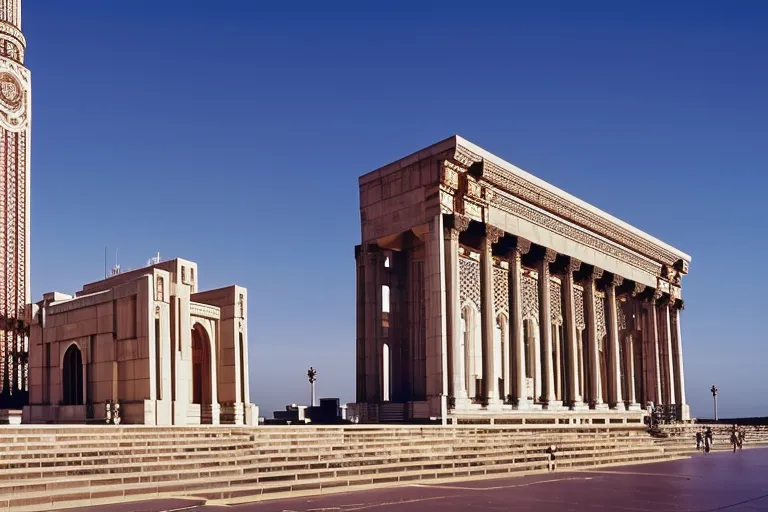Georgia is a country with a rich and diverse history, and its capital city, Tbilisi, is no exception. The city has seen many different rulers and influences over the centuries, and this is reflected in its architecture. From the medieval Old Town to the Art Nouveau buildings of the early 20th century, Tbilisi's architecture is a fascinating window into its past.
The Old Town
The heart of Tbilisi is its Old Town, which dates back to the 4th century AD. This area is a maze of narrow streets and alleyways, lined with traditional Georgian houses and churches. Some of the most notable buildings in the Old Town include:
- The 6th-century Anchiskhati Basilica, one of the oldest surviving churches in Tbilisi.
- The 13th-century Sioni Cathedral, which has been destroyed and rebuilt several times over the centuries.
- The 17th-century Metekhi Church, which sits on a cliff overlooking the Mtkvari River.
Walking through the Old Town is like stepping back in time. The buildings are made of brick and stone, with wooden balconies and ornate carvings. Many of the houses have been converted into shops, cafes, and guesthouses, but they still retain their historic charm.
The Old Town is also home to the Narikala Fortress, which dates back to the 4th century AD. The fortress sits on a hill overlooking the city, and it offers stunning views of Tbilisi and the surrounding mountains. The fortress has been destroyed and rebuilt several times over the centuries, and it is now a popular tourist attraction.
The Persian Influence
In the 17th and 18th centuries, Tbilisi was ruled by the Persian Empire, and this period had a significant impact on the city's architecture. Persian-style buildings were constructed throughout the city, including:
- The 17th-century Tbilisi Baths, which were built in the Persian style and are still in use today.
- The 18th-century Caravanserai, a large inn for travelers that was also built in the Persian style.
These buildings feature intricate tile work and decorative arches, which are typical of Persian architecture. They are a testament to the city's multicultural history and the influence of its Persian rulers.
The Russian Influence
In the 19th century, Tbilisi was annexed by the Russian Empire, and this period saw the construction of many new buildings in the city. Russian-style architecture became popular, and many of the city's most iconic buildings were built during this time, including:
- The 19th-century Tbilisi Opera and Ballet Theatre, which is one of the most beautiful buildings in the city.
- The 19th-century Georgian National Museum, which was originally a Russian military barracks.
These buildings are characterized by their grandeur and ornate decorations, with elaborate facades and intricate details. They are a reminder of the city's time under Russian rule and the influence of Russian culture on Georgian architecture.
One of the most unique buildings from this period is the Rezo Gabriadze Puppet Theatre. Built in the 20th century, the theatre is designed in a whimsical style that combines elements of Art Nouveau and Russian Revival architecture. The theatre is famous for its clock tower, which features a puppet show every hour.
The Art Nouveau Era
At the turn of the 20th century, Tbilisi experienced a period of artistic and cultural growth, and this was reflected in its architecture. Art Nouveau became popular, and many buildings were constructed in this style, including:
- The 20th-century Marjanishvili Theatre, which features Art Nouveau decorations on its exterior.
- The 20th-century Rezo Gabriadze Puppet Theatre, which has an Art Nouveau facade and is a popular tourist attraction.
These buildings are characterized by their flowing lines, decorative motifs, and use of natural materials. They are a testament to the city's artistic heritage and the influence of European culture on Georgian architecture.
Modern Architecture
In recent years, Tbilisi has seen a boom in modern architecture. The city is now home to a number of striking contemporary buildings, including:
- The Bank of Georgia Headquarters, a futuristic building designed by the Italian architect Michele De Lucchi.
- The Tbilisi Public Service Hall, a government building that features a striking glass facade.
These buildings are a reflection of Tbilisi's growing economy and its desire to embrace modernity while still honoring its rich history and culture.
Conclusion
Tbilisi's architecture is a fascinating reflection of its history and culture. From the medieval Old Town to the Art Nouveau and modern buildings of the 20th and 21st centuries, the city's buildings tell the story of its past and present. Exploring Tbilisi's architecture is like taking a journey through time, and it is a must-see for anyone visiting the city.
Keywords to include in the article:
- Tbilisi
- Georgia
- Architecture
- Old Town
- Persian
- Russian
- Art Nouveau
- Modern
- Narikala Fortress
- Rezo Gabriadze Puppet Theatre
- Bank of Georgia Headquarters
- Tbilisi Public Service Hall
- History
- Culture
